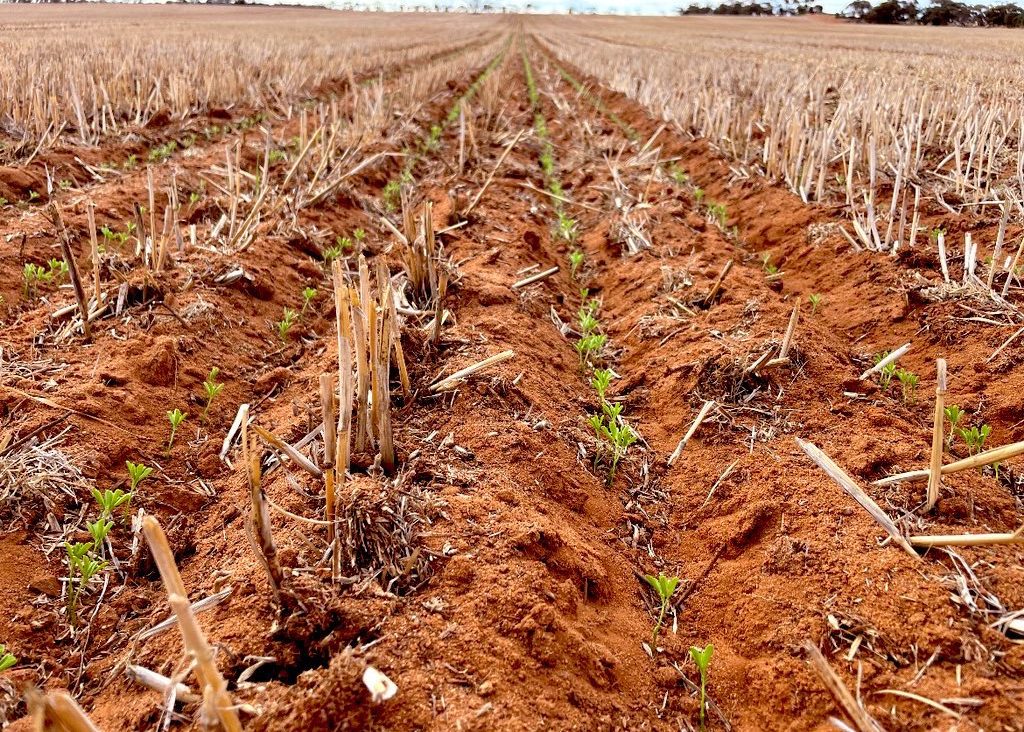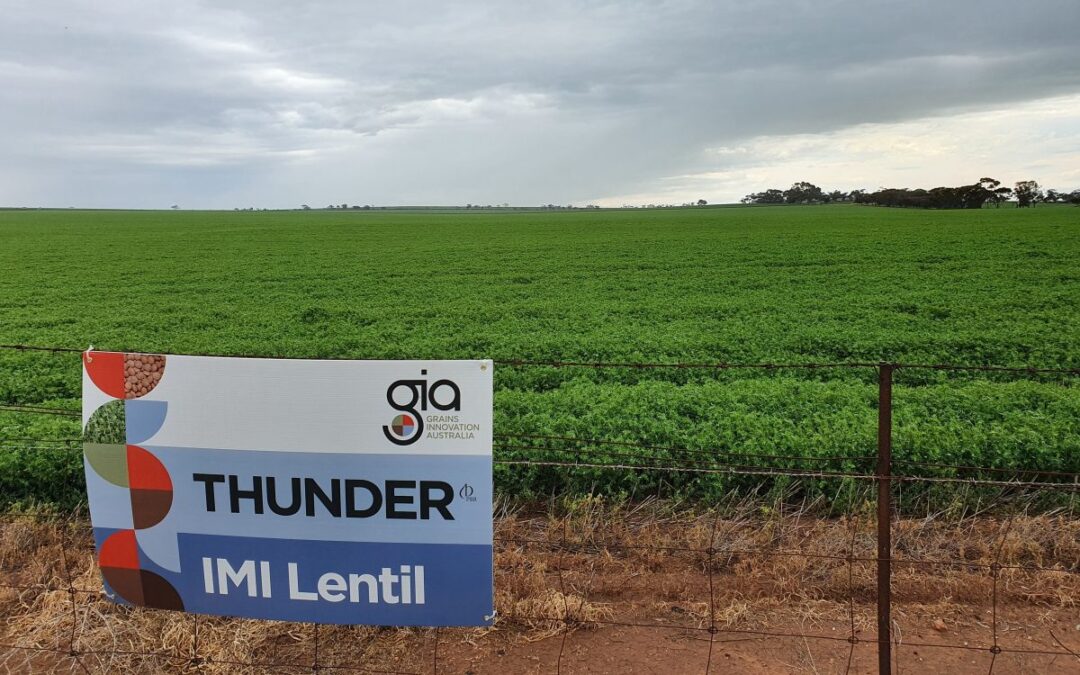Liz Wells
THUNDER and Lightning and a kind start to the season in most growing regions look set to propel Australia’s production of red lentils to new highs in 2023-24.
Both varieties have been bred by Grains Innovation Australia with a market focus, and while Lightning was released commercially last year, Thunder is set to arrive with a bang in the current season.
Lightning is suited to lighter soils and lower rainfall, while Thunder is shaping up as the replacement for Hallmark, with all three available through GIA commercial partner PB Seeds.
NVT results show both can consistently out-yield other smaller Nipper types, and their marketability into South Asian markets is high because of their suitability as “footballs”, or skinned whole product, as well as for splitting.
While a repeat of last spring’s ideal growing conditions is unlikely, gross margins for lentils make them a compelling choice for growers in most regions of South Australia and Victoria.
Lynchpin in rotations
ABARES figures over the past decade chart the rise of primarily red lentils in Australia, with 165,000ha yielding 185,000t in 2012-13 swelling to a record 646,000ha producing 1,412,000t in 2022-23.
Early indications are the 2023-24 crop will set the bar even higher, with planting now complete.
Pulse Australia southern agronomist Phil Bowden said attractive gross margins, and the suitability of Lightning to districts on the northern and western fringe of lentils’ heartland all look set to see further expansion this year, and more in years to come.
“Lentils have changed the face of cropping in a lot of those Vic and SA regions, especially in the alkaline soils”
In SA, the Yorke Peninsula, Upper North and Murray-Mallee have seen a surge in area planted to lentils in recent years, and the same is evident in parts of the Victorian Mallee.
“Things really changed in 2015-16, when growers had high prices, and high yields, and the lentils became the major part of the rotation.
“From 2015-16, they’ve sort of replaced wheat as the main rotation crop.”
“That’s been the watershed, and because they store so well, farmers are quite happy to keep them for 3-4 years and wait for the market to turn in their favour.”
“Just about every year we’ve seen increases in areas of lentils.”
Bulk path emerges
COVID and the havoc it brought to global supply chains hit the pulse market hard, with a paucity of containers available, and freight rates skyrocketing amid unreliable shipping schedules.
The upshot has been that bulk exports of lentils out of SA and Vic ports have boomed, and made elevation margins more attractive for all involved.
“Before COVID, a lot were marketed in containers, and now they’re going in bulk in massive loads; that’s brought the cost down, and farmers are seeing the benefits.”
On more than 2 million tonnes per annum in non-drought years, Canada is the world’s largest lentil exporter by far, but ships mostly green lentils.
Canada’s red lentils do compete with Australian product into South Asia, but predominantly find a home in Turkey, Egypt and the Middle East.
“Our market for those lentils is a niche market.
“Canada doesn’t produce those size and shape; they have bigger green ones.”
“We get premiums for our small red lentils.”
Surge in SA, Vic interest
In South Australia, Upper Eyre Peninsula agronomist Troy Maitland of EP AGnFERT, Kimba, said some growers tried lentils for the first time last year, made good money on them, and are growing them again this year.
“There’s certainly been an increase in Kimba,” Mr Maitland said.
“They’re the flavour of the month; they yielded very well last year, and more and more growers are having a play with them.”
Lentils crops on the Upper EP last year yielded 2-3t/ha, up from a usual 1t/ha.
Selling for at least $700/t on farm, 2022-23 lentils have been the stand-out earner in one of the mildest and wettest springs in living memory.
“When you look at the gross margins on them, they’re pretty good, but it was certainly a season out of the box.
“They’re an opportunity crop for us; September is when we need rain, and so do lentils.”
Mr Maitland said legumes have a place already in many Upper EP rotations, and field peas have shown themselves to be “a bit more resilient” in the dry finishes expected in the region.
Along with colleague Kevin Dart, Mr Maitland said the new varieties hold the promise of yielding better than their predecessors, even during a typically dry spring.
“They have a bit of early maturity, and a bit more tolerance to heat stress,” Mr Dart said.
Mr Maitland said growers want a legume in the rotation as a disease break, and a natural source of nitrogen, and lentils can now fit the bill.
“Once upon a time, the varieties didn’t suit; now varieties are a lot better and more profitable.”

In Victoria, Frontier Farming Systems director Michael Moodie said Thunder has attracted plenty of attention, and was being used in some of the organisation’s trials.
“It’s performed well in NVT, and plenty of people are growing it for seed this year,” Mr Moodie said.
He said the past decade has seen Mallee growers generally wanting to include more legumes in their rotation for the benefits of sustainability, and the solution depended on seasons, soil types and price.
“People are still sorting out what’s right for them.
“As a general rule, lentils and vetch are finding the place most consistently, and after that it’s chickpeas and field peas, with some lupins where it gets sandy.
“With lentils, it’s the high value nature of them that can really work.
“In the southern Mallee, they’ve been quite entrenched for a while; in the northern Mallee from Ouyen up, they’re still finding their place.”
The Mallee can suffer some harsh and dry seasons, and Mr Moodie said these can quash interest in lentils in the rotation.
“We’ll have a couple of good years in a row and see an uptake in lentils, then a run of two bad seasons and people will fall back to field peas or more vetch, so something they see as less risky.
“The people that have the most success with lentils commit to them; you’ll have good and bad years, but people that chase everything will miss that 2t/ha year at $800/t.”
Thunder sells out
PB Seeds has handled the bulking up and sale of Thunder and Lightning, and commercial manager Janine Sounness said seed sales indicate Thunder will be grown over 45,000ha, and Lightning over 10,000ha.
With its yield advantage and comparable disease rating, Thunder is expected to shuffle in on Hallmark territory, while Lightning has potential to push into new areas.
“When you get a variety that has a big jump in yield, which Thunder does, growers are pretty quick to catch on,” Ms Sounness said.
“We’ve had orders in our system since June last year for this variety.
“We’ve been taking an enormous amount of orders and we’ve never had that kind of interest for the first year of release; it’s astonishing.”
Thunder seed crops across SA and Vic yielded 4t/ha in the dream season, and seed has sold out from PB Seeds site at Kalkee in Vic’s Wimmera, and from its SA distributor, AG Schilling & Co on Yorke Peninsula.
“Because of the late season, some crops weren’t harvested until January, when normally it would be November-December.”
Both varieties have come from local genetics, with Lightning bred following some research funded by the South Australian Grain Industry Trust.
Source: Grain Central

